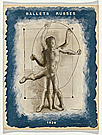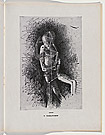Pavel TCHELITCHEV

Pavel Fedorovich Tchelitchew (b Kaluya, Russia, 21 September 1898 – d Grottatterrata, Italy, 31 July 1957) began his art training under the guidance of the stage designer Alexandra Exter and at the Kiev Academy as well as private classes with several Russian artists and stage designers. He continued studying in Berlin, Germany from 1921 until 1923, when he moved to Paris, also travelling to Austria, Italy, Bulgaria and Turkey.
By 1921 he had produced designs for six ballets performed in Istanbul and more in Berlin shortly after. These early theatre designs reflect his preoccupation with geometric forms and Cubism. He followed these early experiments with designs for Le Coq d’or, performed at the Opera House in Berlin in 1923. Financial support came from Gertrude Stein, who purchased the contents of his studio in 1925 after seeing his entry in the Salon d’Automne. His participation in a 1926 group exhibition at the Galerie Druet, Paris gave rise to the term Neo-Romantic for his work. This style was related to Surrealism and concentrated on fantasy created with the use of everyday objects, increasing the viewer’s feeling of unease.
In 1928 Tchelitchew was commissioned by Diaghilev to produce designs for the Ballets Russes production of Ode. Following his move to New York he continued to work in the theatre, designing for George Balanchine’s new American Ballet Company and for Arthur Everett Austin Jr at the Wadsworth Atheneum in Hartford, Connecticut, until 1942 when he gave up stage design to concentrate on his painting.
Pavel Tchelitchew
Self-portrait 1925 oil on canvas 61 x 46 cm
private collection image courtesy of Kournikova Gallery, Moscow





